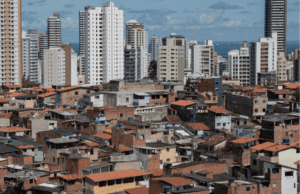
The voluminous data produced by Good Jobs First over 24 years has aided the research of hundreds of academics, whose work has generated scores of academic papers* using our Subsidy Tracker, Violation Tracker, or both.
Today we launch a new series of blog posts to highlight some of this work about subsidies and corporate lawlessness.
First, we focus on one of the most negative consequences of subsidies, rising inequality.
Academic research using Subsidy Tracker finds that states with higher use of economic development subsidies also have higher levels of income inequality. The apparent link: subsidies starve state and local economies’ tax bases so they have less to invest in programs such as food aid, health coverage, or affordable housing. Such programs reduce poverty, especially among Black and Latinx children, and thus can reduce racial disparities. But with excessive subsidies, there is less money going to those public efforts that make people equal.
Another reason incentives are likely to exacerbate inequality is that they benefit owners of capital (i.e., corporate shareholders) while simultaneously reducing state or local government revenue. Scholars find no corresponding increase in income for workers or lower-income people generally. This makes the distribution of income, which has become more unequal for decades, slightly more unequal than it would be if corporations weren’t squeezing communities for taxpayer giveaways.
MORE SUBSIDIES = MORE INEQUALITY
Economist Jia Wang (University of Dayton) and political scientist Joshua Jansa (Oklahoma State) have both published peer-reviewed articles documenting that the expected negative impact of subsidies on inequality does in fact occur. For both of them, this is a continuation of work in their respective doctoral dissertations.
Wang’s article, “Income Inequality and Economic Development Incentives in US States: Robin Hood in Reverse?” co-authored with Stephen E. Ellis and Cynthia L. Rogers and published in Review of Regional Studies, 2018 used Subsidy Tracker data to measure the amount of economic development incentives given by each state.
It then used government data on income inequality measured three ways: The top 10% share of all income, the top 1% share of all income, and a summary of the way income is distributed across a population (a measurement called the Gini coefficient; a score of zero means total equality while a score of one means all the income is being held by one person).
Wang, Ellis, and Rogers found, using data from 41 states for the period 2000-2009, that states with higher use of economic development incentives had higher levels of inequality by all three income measurements.
SUBSIDIES EXACERBATE INCOME INEQUALITY FOR A LONG TIME
Jansa’s article, “Chasing Disparity: Economic Development Incentives and Income Inequality in the U.S. States, published in State Politics and Policy Quarterly in 2020, similarly finds a “large, long-lasting” negative impact of subsidies on income inequality.
Using Subsidy Tracker data for all 50 states to measure the use of economic development subsidies for the period 1999-2014, Jansa found statistically significant evidence that the tax drain caused by incentives lowered states’ ability to fight inequality with education and social redistributive policies such as welfare programs.
In an earlier 2016 article using Subsidy Tracker, Jia Wang found similar evidence that spending on subsidies crowds out money that would have been available for education spending, evident the year after an incentive was given.
Jansa found that the negative effect continues for several years after the use of subsidies. That is, subsidies reduced a state’s ability to counter inequality year after year. He also emphasizes that the effect can be significant: Giving a single large incentive (a mere $200 million in a small state, $1 billion in an average state, or $2 billion in a large state) can increase the income of a top 10% household by almost 1% relative to everyone else. He gives the example of Connecticut, where all households earning more than $109,178 would gain $960 relative to everyone else if a large incentive is given (this is because the pot of money that would otherwise have been available for public spending, which particularly benefits lower-income earners, significantly shrinks).
Deals this size have become all too common: In our Good Jobs First megadeals page, we document more than 140 subsidies above $200 million and 20 above $1 billion.
Taken together, Wang’s and Jansa’s work supports the long-standing argument that lavish economic development incentives lead to a more unequal society. It also highlights the usefulness of Subsidy Tracker for academic analyses.
Kenneth Thomas is a senior fellow at Good Jobs First and Professor Emeritus of Political Science at the University of Missouri-St. Louis.
This is the first in a series chronicling the ways academics have used the work of Good Jobs First in their research. We hope it’ll spark related and additional research, and show the practical ways our data can be used to inform debates and ultimately make economic policy more just and equitable.